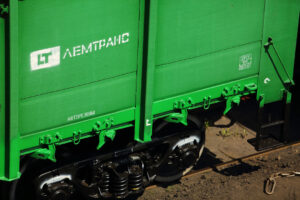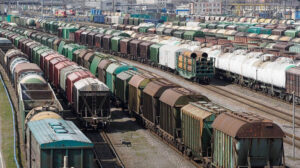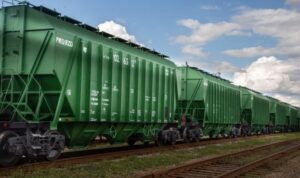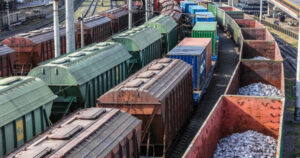
One of the largest grain market operators in Ukraine, Nibulon JV LLC, is entering new markets in the Middle and Upper Danube, expanding its operations in the region and offering a full cycle of grain and metal exports, as well as cargo transportation of all types of goods via the Danube, the grain trader’s press service reported on Facebook.
The agricultural holding reminded that the first steps in the Middle and Upper Danube markets were voyages with metal products on the routes Izmail – Lom (Bulgaria) and Izmail – Smederevo (Serbia), which were carried out by the tugs Pereyaslavsky and Kozatsky using barges of its own production. These shipments confirmed the company’s readiness to work efficiently with various categories of cargo, opening up new business opportunities in Bulgaria, Serbia, Romania and other countries in the Danube region.
“Our fleet is capable of transporting various types of cargo, and this is just the beginning. We offer comprehensive solutions to the Balkan business: grain exports combined with our logistics on the Danube to Constanta, as well as river transportation of any goods between the ports of the region,” said Sergey Kalkutin, Nibulon’s Logistics Director.
Nibulon assured that expansion to the Middle and Upper Danube is part of the agricultural holding’s long-term strategy aimed at developing international river logistics.
Currently, the agricultural holding is ready to offer a competitive alternative to traditional ways of supplying grain and other cargoes. This includes grain exports to 75 countries using its own river fleet, cargo transportation on the Danube for the agricultural, metallurgical and construction sectors, and flexible terms of cooperation: DAP, EXW, FCA, FOB, real-time online cargo tracking, international experience and reputation as a reliable partner.
“Thanks to its own modern fleet and efficient logistics, Nibulon guarantees stable and safe transportation on the Danube, which opens up access to new markets,” the agricultural holding emphasized.
Nibulon JV LLC was established in 1991. Prior to the Russian military invasion, the grain trader owned 27 transshipment terminals and crop reception complexes, facilities for simultaneous storage of 2.25 million tons of agricultural products, a fleet of 83 vessels (including 23 tugs), and the Mykolaiv Shipyard.
“Before the war, Nibulon cultivated 82 thousand hectares of land in 12 regions of Ukraine and exported agricultural products to more than 70 countries. In 2021, the grain trader exported the highest ever 5.64 million tons of agricultural products, reaching record volumes of supplies to foreign markets in August – 0.7 million tons, in the fourth quarter – 1.88 million tons, and in the second half of the year – 3.71 million tons.
Currently, the grain trader is operating at 32% of capacity, has set up a special unit to clear agricultural land of mines and had to move its headquarters from Mykolaiv to Kyiv.
BULGARIA, CARGO TRANSPORTATION, Danube, NIBULON, ROMANIA, SERBIA

The volume of cargo transportation in containers in Ukraine in January-May 2024 reached the highest value for the last seven years and exceeded the pre-war indicators, follows from the analytical note of “Ukrzaliznytsya” (UZ), prepared for the meeting on the topic of intermodal transportation.
“In the first five months of 2024, the volume of cargo transportation in containers increased by 60% compared to the same period of 2023 and amounted to 116.129 thousand TEU (20-foot containers). The indicator is the highest for the last seven years and exceeds the volume of transportation for the same period in 2021 by 10%,” the document says.
It is indicated that in 2021, about 16% of the volume transported in containers accounted for transit, which is now virtually absent.
The main nomenclature in containers remains grain cargoes – 39%, as well as ferrous metals – 15%; cakes – 7%; oil – 6%; synthetic resins – 4%; sugar – 3%, chemicals – 2%.
During the period, about 25% of cargo in containers was transported in the import direction, 61% – in the export direction, 14% – in the domestic direction.
Since March 2023, UZ has been offering users of transportation services a new intermodal service that combines the transportation of container trains, contrailer trains and combined transport trains.
As of June 12, 2024, UZ transported 412 intermodal trains: 72 intermodal trains in the direction of Polish and Romanian ports and 340 such trains in the direction of Ukrainian ports.
It is also reported about changes in the terms of service provision. According to them, operators of intermodal train can postpone the date of its departure in one day, and operators staying outside Ukraine will be able to use UZ fitting platforms at domestic rates.

Lemtrans, Ukraine’s largest private railroad operator, reduced the volume of cargo transportation of various types by 9.6% in 2023 compared to 2022, to 17 million tons.
According to the company’s press service on Friday, the bulk of the cargo transported was coal. It accounted for about 79% of the transportation volume (13.5 million tons).
The company mainly transported coal from mines to power plants, the company said. And while the volume of its transportation remained unchanged compared to 2022, the volume of construction materials increased by 30% to 2.9 million tons. The volume of iron ore cargo decreased the most – by 4.1 times, to 0.4 million tons. Other types of cargo were transported at 0.2 million tons.
“Business still depends on the potential threat of destruction of the frontline industry, logistical bottlenecks such as ports and congestion at the EU border. But despite the war, we are not stopping and are focused on the development of Ukraine. Our investment activities were an important area of focus last year. We are investing in new infrastructure projects, such as the terminal and container business,” the press service quoted Lemtrans CEO Volodymyr Mezentsev as saying.
In 2023, Lemtrans Group invested more than UAH 160 million in infrastructure and logistics projects, mainly in the development of the container business. The development of the Mostyska container terminal (Lviv region) continued.
In addition, it was decided to start design work on two new container terminals in Ukraine.
In 2023, Lemtrans implemented an investment program aimed at further improving the efficiency and increasing the productivity of its car repair facilities.
In 2023, the volume of planned and current repairs of freight cars at Lemtrans’ car repair site amounted to 5.2 thousand units.
In 2023, Lemtrans Group transferred about UAH 929 million to the budgets of all levels. In particular, UAH 840 million was transferred to the state budget. Local budgets were replenished by more than UAH 88 million, and the unified social tax amounted to approximately UAH 64 million.
Last year, the company allocated more than UAH 41 million to support the Armed Forces, the TRO, humanitarian aid to the population and other charitable projects.
Earlier it was reported that the Mostyska container terminal, which began operations in mid-2022, handled more than 72.4 thousand TEU of containerized cargo in 2023, the press service of the Lemtrans logistics company said. The total volume of cargo handled by the container terminal in 2023 amounted to 286 thousand tons. About half of it, 122 thousand tons, was grain cargo, 62 thousand tons – liquid bulk, 35 thousand tons – general cargo, and 37 thousand tons – beam cargo. In addition, in 2023, the terminal received electric vehicles – 36 containers with 108 cars were unloaded.

In November 2023, Ukrzaliznytsia (UZ) transported 14 million tons of cargo, up 33.8% over the same period in 2022 and 4% over October 2023, the UZ press service said on Tuesday.
“It is important that, in addition to domestic transportation, exports, which are critically important for our country, have begun to grow. Thanks to the work of the Ukrainian sea corridor, grain exports have also increased,” said Yevhen Lyashchenko, chairman of the board of UZ.
According to UZ, these are record figures since the beginning of the large-scale invasion.
According to UZ, in November 2023, the company transported 7.3 million tons of cargo on domestic routes, which is 19% more than in November 2022. Export traffic increased by 56.2% to 6 million tons, import traffic by 35.4% to 679 thousand tons, and transit traffic by 2.2 times to 65.5 thousand tons.
It is noted that the largest share of the transported cargo is grain – 3 million tons (+13% by November 2022), construction materials – 3 million tons (+61.8%), iron and manganese ore – 3 million tons (+2.5 times), coal – 2 million tons (7.7% less).
At the same time, in November, 2.4 million tons of grain were exported by rail, which is 13% more than in November 2022 and 40.4% more than in October 2023.
The company also reported that grain transportation to seaports amounted to 1.7 mln tons in November, up 1.7 times compared to the previous month. At the same time, transportation via land border crossings decreased by 4.2% to 720 thsd tonnes.

“Ukrzaliznytsia” has significantly reduced the cost of transportation of grain cargo by rail (by reducing the wagon component of the tariff), and also fixed the average speed of cars for the quarter until September 1, 2023, said Valery Tkachev, deputy director of the department of commercial work UZ.
“From July 1, 2023, the cost of using Ukrzaliznytsia JSC grain railcars is 300 UAH/day without VAT,” he wrote on Facebook.
According to the updated tariffs UZ, the cost of transporting 1 ton of grain by rail is 9.4 $ / ton and 11.4-11.9 $ / ton for a distance of 300 km in the export direction through seaports and dry crossings, respectively, at a distance of 400 km – 11.7 $ / ton and 13.7-14.3 $ / ton; 500 km – 13.4 $ / ton and 15.4-16.3 $ / ton; 600 km – 15 $ / ton and 17.2-18.2 $ / ton.
In particular the cost of transportation takes into account the additional charges at the station of departure (2500 UAH/ton), the two days of use of the car during loading/unloading, freight charges, the return of empty wagons, and other indicators.
The UZ Board will also fix the average speed of movement of cars until September 1, 2023 (per quarter) for the predictability of the work of consignors with the rolling stock UZ.
Previously, average railcar speeds changed monthly and were announced on the 28th.
“This will allow shippers to better plan their work in the cars of Ukrzaliznytsia, as well as accurately calculate the cost of transportation,” – summarized Tkachev and urged shippers of grain cargo to actively use the rolling stock UZ for transportation of grain.

JSC “Ukrzaliznytsia” (UZ) in May this year transported 11.49 million tons of cargo, which is 19.2% more than in May last year.
According to the press-service of UZ, the average daily load also has positive dynamics: the growth is 15,7% – up to 352,8 thousand tons.
Domestic freight traffic in May increased by 36.5% – to 7.17 million tons, export – decreased by 2%. This is due to Russia’s blocking of the sea “grain corridor”. As a result, the volume of grain transportation for export decreased by 29% – down to 806.9 thousand tons. Imports of goods in May increased by 7% – up to 483.4 thousand tons, transit – 47 thousand tons, the company specified.
The leader of the general cargo transportation in May was building materials – 2.5 million tons, coal – 2.22 million tons, iron and manganese ore – 1.96 million tons, grain and milling products – 1.83 million tons, ferrous metals – 816.3 thousand tons. It is noted that the biggest growth is recorded in transportation of construction materials – more than 70%.